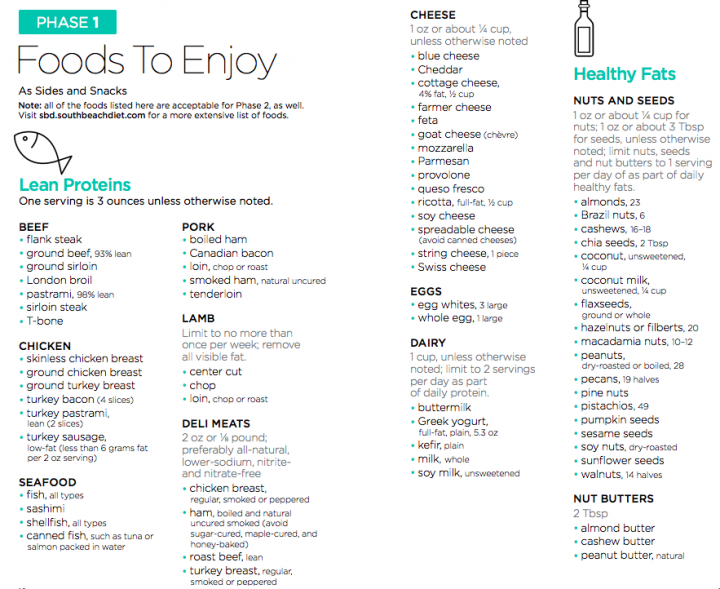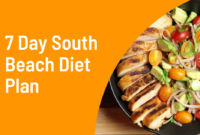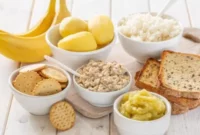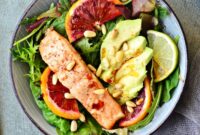South Beach Diet shopping list simplifies navigating the diet’s initial phase. This guide provides a comprehensive weekly shopping list, categorized by grocery store aisle for efficient shopping. We’ll explore Phase 1’s allowed and restricted foods, offering tips for budget-friendly, healthy choices. Understanding the foundational principles of the South Beach Diet is key to success, and this resource helps you build a solid base for your dietary journey.
We’ll delve into the three phases of the diet, detailing allowed and restricted food groups, and offer comparisons to other popular weight-loss plans. Recipe ideas and meal planning strategies are also included, along with advice on overcoming common challenges and preventing potential nutritional deficiencies. The ultimate aim is to equip you with the knowledge and tools to successfully embark on the South Beach Diet.
Understanding the South Beach Diet Principles
The South Beach Diet is a popular weight-loss plan that emphasizes healthy eating habits and sustainable weight management. Unlike many restrictive diets, it focuses on making gradual, manageable changes to your diet rather than drastic cuts. This approach aims to promote long-term weight loss and improved overall health.
The South Beach Diet is structured into three phases, each designed to achieve specific weight loss goals and establish healthy eating patterns. Understanding the principles of each phase is crucial for successful implementation.
The Three Phases of the South Beach Diet
The South Beach Diet progresses through three distinct phases, each with its own set of dietary guidelines. The duration of each phase depends on individual progress and goals, with the ultimate aim of transitioning to a sustainable, healthy lifestyle.
- Phase 1: The Induction Phase (2 weeks): This initial phase focuses on eliminating unhealthy carbohydrates and sugars to stabilize blood sugar levels and reduce cravings. Allowed foods include lean protein, healthy fats, and non-starchy vegetables. Restricted foods include sugary drinks, bread, pasta, most fruits, and processed foods. The goal is to jump-start weight loss and establish healthy eating habits. For example, a typical breakfast might include eggs with spinach and a small amount of cheese, while lunch might consist of grilled chicken salad with olive oil and vinegar dressing.
- Phase 2: The Weight-Loss Phase (until goal weight is reached): This phase gradually reintroduces some healthy carbohydrates, such as whole grains and fruits, while still limiting unhealthy carbohydrates and sugars. The focus remains on balanced meals and portion control. The speed of weight loss slows compared to Phase 1, but this sustainable approach helps prevent weight regain. Examples of additions include small portions of berries and whole-grain bread.
- Phase 3: The Lifetime Maintenance Phase: This phase focuses on maintaining a healthy weight and lifestyle. It involves continued adherence to healthy eating principles learned in the previous phases, but allows for more flexibility and occasional indulgences. This phase emphasizes long-term sustainability and the integration of healthy eating habits into daily life. It allows for a more varied diet, including occasional treats in moderation.
Allowed and Restricted Food Groups in Each Phase
The South Beach Diet carefully manages the types and quantities of food allowed in each phase. This controlled approach helps regulate blood sugar levels and promote healthy weight loss.
| Phase | Allowed Foods | Restricted Foods |
|---|---|---|
| Phase 1 | Lean protein (fish, chicken, beans), healthy fats (olive oil, avocados), non-starchy vegetables (broccoli, spinach, lettuce) | Sugary drinks, bread, pasta, most fruits (except berries in small amounts in Phase 2), processed foods, high-glycemic index foods |
| Phase 2 | All foods from Phase 1, plus some fruits (berries), whole grains (in moderation) | High-glycemic index foods, excessive amounts of unhealthy fats, processed foods |
| Phase 3 | A balanced diet with emphasis on whole, unprocessed foods; occasional treats in moderation | Unhealthy fats, processed foods, excessive amounts of sugar and refined carbohydrates |
Comparison of the South Beach Diet to Other Popular Diets
The South Beach Diet distinguishes itself from other popular diets through its emphasis on healthy fats and its gradual introduction of carbohydrates. Unlike very low-carb diets like Keto, which drastically restrict carbohydrates, the South Beach Diet allows for some healthy carbohydrates in later phases. Compared to diets like Weight Watchers, which focus on calorie counting and points systems, the South Beach Diet emphasizes the quality of food consumed over mere calorie restriction. It also differs from diets focusing solely on eliminating specific food groups, such as the elimination diet, by focusing on a balanced approach to healthy eating. The long-term sustainability aspect of the South Beach Diet sets it apart from many short-term, restrictive diets that often lead to weight regain.
Essential Grocery List Items
Successfully navigating the South Beach Diet, particularly Phase 1, requires careful planning and a well-stocked pantry. This section provides a sample grocery list, organized by store aisle, to simplify your shopping and ensure you have all the necessary ingredients for a week of delicious and healthy meals. We will also offer tips for selecting budget-friendly, high-quality options that align with the diet’s principles.
Phase 1 South Beach Diet: A Week’s Worth of Groceries
This sample shopping list covers a week’s worth of meals adhering strictly to the restrictions of Phase 1 of the South Beach Diet. Remember to adjust quantities based on your individual needs and preferences. This list prioritizes lean protein, healthy fats, and non-starchy vegetables.
- Protein: Salmon (2 fillets), Chicken breasts (4), Extra-lean ground turkey (1 lb), Eggs (1 dozen), Canned tuna (2 cans)
- Healthy Fats: Olive oil, Avocado (2), Nuts (almonds, walnuts – ½ cup total), Chia seeds (1 tbsp), Flax seeds (1 tbsp)
- Non-Starchy Vegetables: Spinach (1 container), Broccoli (1 head), Asparagus (1 bunch), Bell peppers (2), Onions (2), Celery (1 bunch), Mushrooms (1 container), Cucumber (1), Lettuce (1 head)
- Other: Lemon (2), Garlic (1 bulb), Unsweetened almond milk (1 carton), Plain Greek yogurt (1 container), Herbs (basil, parsley, oregano)
Organized Shopping List by Grocery Store Aisle
Organizing your shopping list by grocery store aisle saves valuable time and ensures you don’t miss any essential items. This example assumes a typical supermarket layout. Adjust this based on your local store’s organization.
- Produce Section: Spinach, broccoli, asparagus, bell peppers, onions, celery, mushrooms, cucumber, lettuce, lemons, garlic, avocados.
- Meat & Seafood Counter: Salmon fillets, chicken breasts, extra-lean ground turkey.
- Dairy & Refrigerated Section: Eggs, unsweetened almond milk, plain Greek yogurt.
- Dry Goods/Pantry: Olive oil, almonds, walnuts, chia seeds, flax seeds, canned tuna.
- Spice Aisle: Herbs (basil, parsley, oregano).
Tips for Selecting Healthy and Affordable Options
Sticking to a diet can be expensive, but smart shopping can mitigate costs.
Prioritize purchasing in-season produce: Seasonal fruits and vegetables are typically cheaper and more flavorful. For example, asparagus is often less expensive in the spring.
Buy in bulk when appropriate: Items like nuts, seeds, and certain spices can be more cost-effective when purchased in larger quantities. However, be mindful of storage requirements to avoid spoilage.
Compare unit prices: Pay attention to the price per unit (ounce, pound, etc.) rather than just the total price. This helps ensure you’re getting the best value for your money.
Consider frozen options: Frozen fruits and vegetables are often just as nutritious as fresh and are typically more affordable and have a longer shelf life.
Plan your meals: Planning your meals in advance helps prevent impulse purchases and reduces food waste. Sticking to a shopping list minimizes the temptation to buy items outside of your dietary plan.
Addressing Potential Challenges
Embarking on the South Beach Diet, like any dietary change, presents certain hurdles. Understanding these common obstacles and developing effective coping mechanisms is crucial for long-term success and sustainable weight management. This section addresses common challenges, offering practical strategies to overcome them and maintain a healthy approach to the diet.
Many individuals find the initial adjustment to the South Beach Diet’s restrictions challenging. The elimination of certain food groups, particularly refined sugars and processed carbohydrates, can lead to cravings and feelings of deprivation. Furthermore, maintaining motivation over the long term requires a concerted effort and a clear understanding of the diet’s principles.
Overcoming Cravings and Maintaining Motivation
Successfully navigating the South Beach Diet often hinges on effectively managing cravings and sustaining motivation. A proactive approach is key, focusing on both short-term craving management and long-term commitment strategies.
Strategies for managing cravings often involve substituting unhealthy choices with healthier alternatives. For instance, a craving for sugary snacks can be addressed by opting for a small portion of berries or a piece of dark chocolate (with a high percentage of cacao). Keeping a food journal can help identify trigger foods and situations that lead to cravings, allowing for proactive planning and avoidance. Regular exercise not only contributes to weight loss but also helps manage stress and reduce cravings. Finally, setting realistic goals and celebrating small victories along the way helps maintain motivation and prevents feelings of discouragement.
Addressing Potential Nutritional Deficiencies
While the South Beach Diet emphasizes whole, unprocessed foods, the restriction of certain food groups can potentially lead to nutritional deficiencies if not carefully managed. Proactive planning and supplementation, where necessary, can mitigate these risks.
For example, the initial phase of the South Beach Diet restricts many fruits and some vegetables. This can potentially lead to reduced intake of certain vitamins and minerals. To prevent deficiencies, it’s crucial to focus on consuming a wide variety of permitted fruits and vegetables, paying particular attention to nutrient-dense options like leafy greens, berries, and cruciferous vegetables. In some cases, a multivitamin supplement may be beneficial, especially during the initial phases of the diet. Consulting a registered dietitian or healthcare professional can provide personalized guidance to ensure adequate nutrient intake and address any specific concerns.
Visual Representation of Food Groups
Understanding the visual aspects of the South Beach Diet’s Phase 1 food groups can significantly aid in meal planning and adherence. A clear mental picture of what constitutes an appropriate meal helps to avoid dietary pitfalls and promotes successful weight management. This section provides detailed descriptions of visual representations of both the allowed food groups and appropriate portion sizes.
Phase 1 Food Group Visual Representation
Imagine a vibrant, colorful plate brimming with the diverse foods permitted in South Beach Diet Phase 1. The dominant colors would be deep greens from leafy vegetables like spinach and kale, vibrant reds and oranges from bell peppers and tomatoes, and the earthy browns of whole grains like quinoa or brown rice. You’d also see the pearly whites of lean protein sources such as grilled chicken breast or fish, and the creamy off-white of healthy fats like avocados. The textures are equally varied: the crisp crunch of vegetables, the tender flakiness of fish, the satisfying chew of whole grains. The overall impression should be one of abundance and variety, far from the restrictive feeling often associated with dieting. This visual representation highlights the diet’s focus on nutrient-dense, unprocessed foods. A specific example could include a portion of grilled salmon, a generous serving of steamed broccoli, and a small side of quinoa. The colors are rich and natural, showcasing the beauty of unprocessed ingredients.
Recommended Portion Sizes Visual Representation
A helpful visual aid for portion control would be a series of images depicting recommended serving sizes for each food group. For example, a lean protein serving might be illustrated as a deck of cards (approximately 3-4 ounces) of grilled chicken breast. A serving of non-starchy vegetables could be visualized as a baseball-sized portion of broccoli florets. Healthy fats, such as avocado, might be shown as a quarter of a medium-sized avocado. A serving of whole grains could be represented as a half-cup of cooked quinoa, similar in volume to a standard coffee mug. These images, alongside measurements, would provide a clear and easily understandable guide to portion control. Consistent use of these visual cues reinforces the importance of mindful eating and prevents overconsumption, which is crucial for successful weight loss. The visuals should be simple, clear, and relatable, avoiding complex or ambiguous representations. The emphasis should be on the quantity, ensuring the viewer can easily gauge the correct portion size.
Closing Summary
Successfully navigating the South Beach Diet requires careful planning and a well-stocked pantry. This guide has provided a framework for creating your own South Beach Diet shopping list, emphasizing efficient shopping strategies and healthy food choices. By understanding the principles of the diet and utilizing the provided resources, you can confidently embark on your weight-loss journey, armed with the knowledge and tools for success. Remember consistent effort and mindful choices are key to achieving your health goals.




